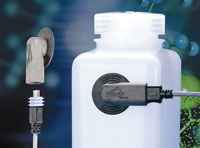
Posted to News on 26th Nov 2013, 00:00
Improve output with modern level sensors
Modern level measurement components offer engineers huge potential to protect and increase the quality of plant output. Charlie Sorbo of Gems Sensors looks at some recent innovations.

>Modern engineering, with its increasingly sophisticated processing systems, demands ever-tighter degrees of control, and this has led engineers to seek more reliable level measurement systems. Boosting the accuracy and performance of level measurement reduces the variability of product output, resulting in the measurable benefits of higher output quality, reduced cost and less waste. While these benefits alone are attractive enough, it is also in the interest of manufacturers to stay up-to-date with level measurement developments from a defensive point of view; increasing legislation across industry sets stiff requirements for reliability and sustainability and the newest level measurement technologies are powerful tools in helping plant engineers to meet these goals.
>Conductivity-based sensors are now available that can detect the level of water in fuel and lubricating oil and prevent mechanical damage as a result of lubricant property degradation. Gems Sensors and Controls' own work in this area has resulted in the launch of the WIF-1250, a no-moving-parts solution for use with fuel filters, and in compressor crank cases to determine if water is present in the lubricating oil. The WIF-1250 contains integral, high-temperature-rated electronics that generate an alternating voltage to a probe tip. The presence of water completes the circuit, which, in turn, changes the condition of the transistor output. The output options of the sensor can be used to actuate relays, indicator lights or LEDs, as well as to interface with CMOS/TTL logic, PLCs or microprocessors.
>Solutions such as this add reliability to fluid measurement; historically, the presence of water in fuel would have more likely been discovered after some damage had been done, whereas today's solutions prevent problems from occurring in the first place. As with measurements for particle contamination in fuel, which were once conducted by means of a simple visual inspection of a sample transferred into a clear vessel, judging the presence of water in fuel is haphazard without sensor technology. It has even been known for visually inspected fuel to be judged contaminated and rejected when, in fact, fibres of lint that have become detached from the cloths used to wipe clean the sample jars were, in fact, the only contamination present. This only goes to underline the importance of sensor technology as a reliable means of measurement.
>Side mount level switches in engineered plastic for high temperature applications have also proved to be a powerful innovation. These extremely versatile components are currently available in a form that is compatible with a wide range of challenging fluids, such as oils and solvents, with resistance to temperatures of up to 148.9°. As an affordable solution for handling high temperature applications and corrosive fluids, these switches have proved invaluable for use within methylene chloride and anti-freeze tanks, and are well suited for low coolant, low hydraulic monitoring within off-highway vehicle and transportation applications.
>Electro-optic sensors offer a further method of measuring level. An electro-optic sensor contains both an infrared LED and a light receiver. Infrared light from the LED is directed into a prism at the tip of the sensor and, when no liquid is present, the light is reflected within the prism to the receiver; however, when liquid rises in the vessel to immerse the prism, the light from the infrared LED is refracted out into the liquid. At this point, there is no longer any light reaching the receiver, which actuates electronic switching to operate an external alarm or control circuit. There are now electro-optic components on the market with the potential to operate within extreme temperatures ranging between -40C and +125°C, offering ingress protection ratings of IP66 and upwards, which can be utilised even within extreme environmental conditions.
>As OEMs discover the array of solutions now available for sensing level, the designers and engineers of these systems are constantly discovering new ways to provide simple solutions to common problems. All these innovations in level measurement offer huge potential but to get the best from any component you need to ensure the right specification for your operations. This may even involve supplying a sample of the process material for evaluation, along with a diagram of the vessel, when working with your sensor supplier. The effort will be worthwhile and ensure maximum performance with minimal maintenance requirements for your industrial and process operations.






